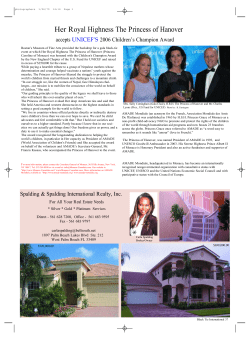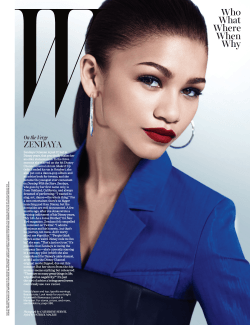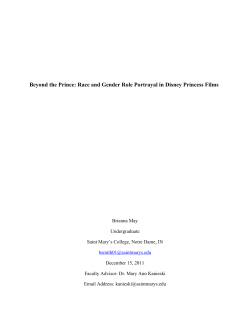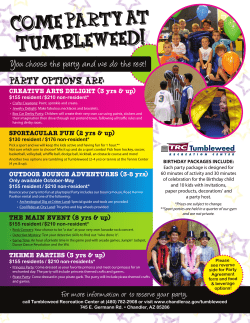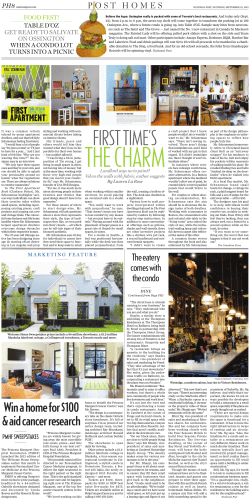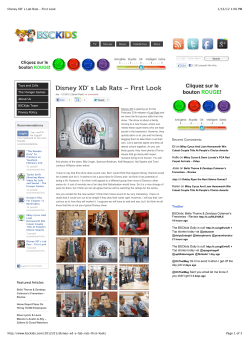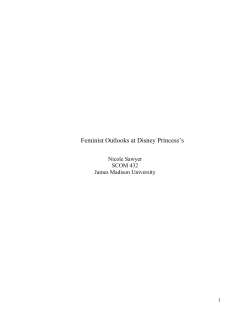
Elisabeth Buck Department of English/098 University of Nevada, Reno Reno, NV 89557-0098
Buck 1 Elisabeth Buck Department of English/098 University of Nevada, Reno Reno, NV 89557-0098 [email protected] 775-750-8899 Describing the Disney Princess: Analyzing the Connections Between Gender and Language in Female Disney Royalty Abstract Princesses are often blamed for perpetuating gender dichotomies, as well as for instilling in children—particularly young girls—the idealistic notion of “happily ever after.” The Disney versions of this archetype, mainly due to their current cultural prominence, receive particular culpability for promoting materialism, superficiality, stereotypes, and other negative qualities. This study aims to assess the correlation between a princess’s level of recognition and the words used to describe her. By soliciting and examining responses from both first-grade elementary school girls and older females (ages 10+), this inquiry analyzes the current standing of the Disney Princess in the American cultural marketplace. The results suggest that there is a direct and demonstrable association between traditionally feminine, superficial descriptors and relative popularity, as indicated by both character preference and placement on official merchandise. Buck 2 Introduction The concept of the “Disney Princess” was established in Walt Disney’s first full-length animated feature film, the 1937 release Snow White and the Seven Dwarfs. The movie introduced audiences to Snow White, a kind and beautiful girl with a persistent mantra: “Someday my Prince Will Come.” The genre then grew to include other titular protagonists with similar personas and aspirations—1950’s Cinderella and 1959’s Sleeping Beauty (Princess Aurora). Following Walt Disney’s death in 1966, films featuring royal female characters took a nearly quarter-century hiatus, until 1989’s The Little Mermaid produced red-headed Ariel. She was quickly joined by Beauty and the Beast’s Belle (1991) and the first non-Caucasian prototype, Jasmine from 1992’s Aladdin. A very different kind of princess was revealed in both 1995’s Pocahontas and 1998’s Mulan: these two films featured, respectively, a Native American and a Chinese woman who stood up to patriarchal norms by engaging in active resistance to cultural and gender mandates. Pocahontas is the only royal individual thus far whose film does not end in resolution through romantic attachment (at least, not until the sequel—1998’s straight-to-video Pocahontas II: Journey to a New World). Mulan also defies gender (and genre) stereotype by engaging in armed combat—in order to save her father, she cross-dresses and joins the Chinese army’s fight against the invading Huns. The most recent princesses, Tiana from 2009’s The Princess and the Frog—Disney’s first African-American female heroine—and Rapunzel from 2010’s Tangled, return to a more conventional model: each tale ends with the pretty protagonist wed to the man of her dreams. These ten characters (pictured in Appendix A) comprise the official Disney Princess “brand,” a franchise that includes more than twenty-six thousand items and—as of 2009—has grossed an astonishing four billion dollars worldwide (Orenstein 14). And yet, though Snow Buck 3 White has existed for nearly eighty years, the “Disney Princess” as a cohesive model is a relatively recent phenomenon, and whose development reflects a desire by Disney to coordinate and control a particular share in the marketplace. In 2000, Disney executive Andy Mooney went to a showing of “Disney on Ice” and noticed that many of the young girls in attendance were wearing homemade princess costumes (Orenstein 13). Recognizing the profit potential in targeting this interested and devoted demographic, Mooney proposed uniting the Disney royalty on merchandise in a coherent brand. The tactic was an immediate success: according to Peggy Orenstein, author of Cinderella Ate My Daughter, “‘Princess’ has not only become the fastestgrowing brand the company has ever created, it is the largest franchise on the planet for girls ages two to six” (14). For Disney, the development of the Princess brand has plainly served their interests, both in terms of accessing a previously untapped revenue stream, and unifying a particular aspect of Disney iconography. This does not mean, however, that all princesses are represented equally. Cinderella, Sleeping Beauty, Ariel, Belle, and Rapunzel—as the most recent incarnation—are commonly featured in stores. Snow White and Jasmine, Orenstein notes, “are in the pantheon, too, though slightly less popular,” as is The Princess and the Frog’s Tiana (14). In contrast, the remaining princesses—Mulan and Pocahontas—are so excluded from representation on merchandise that their official inclusion within the Princess canon is frequently questioned.1 This project thus aims to assess the extent to which this privileging of particular princesses is correlated with how these characters are described, to explore whether increased designation through superficial and/or gendered terminology (for instance, “beautiful”) has any bearing on overall popularity. As a linguistic project, then, this exploration considers whether or not the ways in which we speak Buck 4 about Disney’s Princesses impacts the ways in which they enter into consumer practices and the American cultural consciousness. This project also poses an inquiry into the cultural work that Disney’s Princesses undertake. Larger research questions at stake here concern the implications of the Disney Princess brand as wielding substantial and pervasive economic and cultural influence, especially since the Princesses are directed at the two-to-six-year-old demographic. What might be the effect on young girls if the Princesses who most deflect or complicate gender stereotypes are consistently excluded from representation? To what extent can we expect representations of Princesses to empower, shift, or maintain perceptions of women as young girls grow into adulthood? These questions, while outside the immediate scope of this paper, inform this work’s intention to explore cultural studies by examining how language and representation merge in product placement to produce particular responses. The current project thus aims to assess how females—both within and outside the target princess demographic—conceptualize the Disney Princesses. At the same time, the purpose of this work is neither to vilify nor to excuse Disney’s marketing choices, but, rather, to unify language and thought. There remains much to be done in terms of understanding how Americans make sense of this popular and deliberately constructed phenomenon. In other words, how we think about these Princesses matters, and these first steps are necessary to look at broader cultural influence. Critical Analysis of the Disney Princess Peggy Orenstein’s 2011 study, Cinderella Ate My Daughter: Dispatches From the Front Lines of the New Girly-Girl Culture, contextualizes and examines the current national preoccupation with princesses. Orenstein provides an in-depth look at girly-girl consumerism, and approaches this Buck 5 by examining such diverse topics as the “princessification” of Nickelodeon’s Dora the Explorer, pre-teen beauty pageants as revealed on the TLC program Toddlers & Tiaras, and the obsession with Disney’s “real-life” princesses, such as Miley Cyrus.2 What makes Orenstein’s text particularly pertinent is her analysis of the repercussions of this princess fixation; if these characters are the purveyors of physical perfection and idealized femininity, then how does the inundation of “Cinderella Band-Aids, Cinderella paper cups, Cinderella cereal boxes, Cinderella pens, Cinderella crayons, and Cinderella notebooks” impact young girls? (62). This is a question she examines by focusing explicitly on how princesses are sold: they, Orenstein suggests, are “a cog in the round-the-clock, all-pervasive media machine aimed at our daughters—and at us— from womb to tomb; one that, again and again, presents femininity as performance, sexuality as performance, identity as performance, and each of those traits as available for a price” (183). The privileging of certain princesses over others thus perpetuates particular attributes as most ideal; Orenstein suggests that Mulan and Pocahontas’s absence from most princess products is due to their lack of “bling potential.” She notes that “you can gussy up Pocahontas’s eagle feathers only so much” and Mulan, “when she does show up, it’s in a kimono-like hanfu, the one that makes her miserable in the movie, rather than in her warrior’s gear” (14). Orenstein’s argument proceeds from an assumption that “princess,” as an ideological category, serves to undermine other endeavors to build-up girls’ self-esteem, that princesses are somehow self-evidently harmful. And furthermore, Orenstein connects this with the consumer marketplace, in the buying and selling of identity categories. While Orenstein also briefly engages with ideas of gender and identity formation, the ways in which people—as consumers, to keep within Orenstein’s vocabulary—come to identity is not merely through mindless consumption, where corporations like Disney force both products and ideology onto unwitting Buck 6 parents (and children.) Rather, the interest in and purchase of Princess merchandise comes from both Disney’s status as a global marketing powerhouse, as well as from a host of other factors— from gender and race, to class, regional location, religious affiliation, and, importantly, language use—that consumers evaluate in the moment of purchase, often without their conscious knowledge. These choices are not always made in ways that are necessarily rational, but they nonetheless reflect a series of what might be called “non-rational” (rather than irrational) choices that reveal what attributes consumers value. What this study examines is a particular segment of this unconscious choice as conveyed language use, as it tracks whether there is a further reasoning for the exclusion Orenstein wonders about. The issue is perhaps not just the lack of “bling potential,” but that Mulan and Pocahontas are not rhetorically perceived and positioned as embodying a physical ideal to the same extent as a character like Cinderella. Orenstein, for her part, is aware of the ways in which language inflects how we see the world, and incorporates some amount of rhetorical inquiry into her work, though in a limited way. As she explains, Disney Princesses are associated with particular language descriptors. Orenstein cites a Disney-sponsored survey in which preschool girls’ mothers were asked to describe the characters; the results indicated that “rather than ‘beautiful,’ the women more strongly associate princesses with ‘creating fantasy,’ ‘inspiring,’ ‘compassionate.’ And ‘safe’ ” (24). Orenstein suggests that the princesses’ apparent embodiment of sweetness and charm fends off premature sexuality—the princess exists as the wholesome alternative to Kim Kardashian. If parents, however, tend to disassociate “princess” with “beautiful,” then there may be a fundamental difference in how princesses are being negotiated along the age spectrum. This aspect is something that is readily juxtaposed with the aims of this study: Are the children of these parents also able to focus on the “character” of these princesses and not describe them in Buck 7 terms related to physicality? In other words, parents contribute important early vocabulary to how the Princesses are understood—from “authorizing” the Princesses as an acceptable plaything in the act of purchase, to language use when explaining the Princesses to their children—and so that vocabulary needs consideration as well. In their multi-disciplinary social science study, “Gender Role Portrayal and the Disney Princess” (2011), England, Descartes, & Collier-Meek perform a content coding analysis of the Disney Princess films (with the exception of the most recent, Tangled.) As they describe it, their intention in this study is to “provide a systematic, quantitative comparison of the main characters’ attributes, actions and outcomes in a thematically unified, highly popular grouping of Disney films” (557). England, Descartes, & Collier-Meek also include an extensive literature review on theories of how children learn and perform gender roles, placing special emphasis on the constructionist approach and cultivation theory. The former suggests that children “develop beliefs about the world based on experiences,” and consequently introduction to stereotype will influence how children view gender; the latter “posits that exposure to television content helps develop concepts regarding social behavior and norms” and thus higher levels of exposure lead to stronger impacts on gender socialization (557). With these potential implications in mind, the present study will add to this discussion by assessing if children—and the adults who buy princess products—view these characters as associated most prominently with superficial labels. The Disney Princesses, because of their prominence and cultural influence presented at such an early age, may therefore contribute to the perpetuation of gender stereotype. England, Descartes, & Collier-Meek’s study identified thirteen “masculine” qualities— such as brave, independent, and assertive—as well as sixteen stereotypical “feminine” qualities—like fearful, helpful, and tentative—and used these for content coding analysis (558- Buck 8 560). The researchers assessed each prince and princess in the nine “Princess films” and determined which characters are most emblematic of gender stereotypes. The protagonists were assessed using both the masculine and feminine traits; therefore each character has two “scores.” Cinderella, Snow White, and Ariel embodied the three highest levels of feminine coding characteristics, and, similarly, the earliest three princesses (Snow White, Cinderella, and Sleeping Beauty) had the least usage of the masculine traits. The researchers’ analysis of their results is particularly useful when paired with the aims of the current study. England, Descartes, & Collier-Meek note that “the three most recent movies, Pocahontas (1995), Mulan (1998), and The Princess and the Frog (2009), had princesses who displayed more masculine than feminine characteristics in their three most frequent characteristics. This suggests a chronological movement towards a more androgynous princess” (562). This is in distinct contrast to a character like Aurora (Sleeping Beauty’s real name) who the authors describe as “the most frequently affectionate, described as pretty, and tentative” (562). In this way, we see how the transference of value is encoded by language, and carries with it immediate interpretive possibilities. Perhaps the most important aspect of the Princess is her physical appearance, as the integral part of each Princess’s character is necessarily portrayed in large part by her representation in animated feature films, which are then transferred to the products. This concern communications scholar Celeste Lacroix takes up in her 2004 article, “Images of Animated Other: The Orientalization of Disney’s Cartoon Heroines from The Little Mermaid to The Hunchback of Notre Dame.” Lacroix performs a “critical textual analysis of both the White heroines and the women of color” and particularly notes the variations in physicality among these female protagonists (219). Although she assesses only five characters—Ariel, Belle, Jasmine, Pocahontas, and non-princess Esmeralda3 from 1996’s The Hunchback of Notre Buck 9 Dame—Lacroix makes several interesting comparisons between how the Caucasian princesses are represented in contrast to the ethnic characters. She notes that there is an increasing focus on the body in the characters of color. Whereas the costuming of these characters [Jasmine’s harem-like, midriff-revealing outfit and Pocahontas’s miniskirt-like Native American garb] reflects stereotypical images of each woman's ethnicity, the overall effect, taken with the increasing voluptuousness of the characters, works to represent the White characters as more demure and conservative, while associating the women of color with the exotic and sexual. (222) Since it is two of the ethnic “other” princesses who are most constantly excluded from princess merchandise, Lacroix’s analysis validates an important consideration: How does representation as “exotic” or “othered” influence the terms applied to Jasmine, Mulan, Pocahontas, and Tiana? Another point of scrutiny that is also noteworthy in Lacroix’s piece is when she notes, “we ask ourselves, what are children being taught? First and foremost, they are taught to consume. Young people are imbricated into a material practice of consuming these films and products and are taught from a young age how they are to experience them” (226). If individuals are literally buying into certain princesses, they are privileging them as the paradigm. Disney Princess commodification is thus critical to the reading of these characters as having significant implications on perceptions and conceptualizations of gender and femininity. Experimental Method The present study focused on two distinct populations: female elementary school students in first grade, and a range of older girls and women outside of the target princess demographic. Most first graders are in the 6-7 years old age range; they are consequently the group most able to articulate their opinions while still remaining within Disney’s “target audience.” The only restrictions placed on the latter group were that participants needed to be female and at least 10 years of age; the purpose in including this population in the analysis helps assess whether views Buck 10 on Princesses alter as a result of maturing outside the target demographic. Males were excluded from this assessment, primarily due to the tie to commodification: men are generally not the demographic that Disney targets for the purposes of princess consumption. A subsequent study, however, might consider how gender stereotypes are revealed in male Disney Princess preference, as well as a more specific approach that would include larger samples of older girls and women split into age groups. As a start, though, the information garnered from this work I suggest will necessitate the need for this further study. Two different surveys were designed for the purpose of assessment (see Appendix B). The first survey, distributed to 39 female first grade students at an elementary school in Reno, Nevada, requested the participant’s age and ethnicity. It included an illustration of the current roster of Disney Princesses, with the names of the princesses labeled underneath the drawing.4 Due to the age of the participants, the survey strove to be simple in its direction and intent, simply requesting that the student state her favorite princess and write two words to describe her. This was done to measure to what extent these students would engage with superficial markers of description: Would students comment on the character of the princess (by using words like kind, fun, good, etc.) or adjectives commenting on some physical aspect of the princess (pretty, beautiful, tall, or some reference to hair/clothes/eye color)? The second survey, given to the older participants, was designed to be more complex in its aims. In addition to asking age and ethnicity, the poll requested that respondents identify their favorite princess and the reason for that choice. The other portion of the survey required participants to match particular, previously chosen adjectives with each princess. The adjectives utilized came from a range of descriptors, some used in the studies previously cited: brave, kind, innocent, independent, sensitive, rebellious, pretty, attractive, affectionate, and beautiful. The respondents were asked to use each Buck 11 word only once and apply the adjective to the princess that they believed best suited the term. By forcing participants to be exclusive in their choices, the goal was to discern which princess is viewed as exemplifying each trait; the princess who the participant considers most beautiful will likely be given that designation. These particular adjectives were chosen because they can be classified under three categories: superficial descriptors (beautiful, pretty, attractive), traditionally feminine adjectives (kind, innocent, sensitive, affectionate), and androgynous descriptors (brave, independent, rebellious.) These adjectives were also selected because each one (with a few exceptions) could feasibly be applied to any of the princesses. Mulan, for example, could certainly be described as “beautiful,” and even the most stereotypically feminine princesses still perform actions that could be considered “brave.5” This survey was dispersed by hand to 39 individuals; a digital version was distributed through the social networking site Facebook. Surveys filled out by male participants and those that failed to follow the directions (for instance, those that used the same adjective multiple times) were discarded. Thus, a total of 134 viable responses to this second survey were collected. Some limitations of this experimental method should be addressed. First, the pool of participants was limited to individuals within the author’s own geographical position and situation. Although distribution through Facebook permitted a more diverse sample population, the results likely privilege the opinion of a certain demographic that included technologically savvy participants with access to the Internet, as well as within the middle range of Facebook’s user age profiles. The average age of the participants in the second survey was 25.21, and the ethnic breakdown of the respondents was as follows: 76% Caucasian, 13% Hispanic, 5% Other, 3% African-American, and 3% Asian/Pacific Islander. Additionally, some participants noted that there was no “unknown” or “unsure” option when pairing the adjectives. There is therefore a Buck 12 margin of error, as some individuals were likely forced to apply an adjective to a princess whose movie they had not seen and/or were not familiar with. The large sample size of respondents, however, should theoretically negate some of this inaccuracy, not to mention that, in terms of practicality, the possibility of finding an ideal group of knowledgeable Disney Princess enthusiasts would produce a sizable error in its own execution. The survey to first grade students was distributed to three different classrooms, and one teacher neglected to note the students’ demographic information. Since the absence of this data represented a third of the overall respondents, the decision was made to exclude the ethnicity component from analysis in this survey. Results The survey to older females was analyzed along several criteria. The first of which was a simple analysis of the overall favorite princess among all 134 respondents: The second aspect measured in all responses was the adjective associated with the participant’s favorite princess. This was not measured using the “why” comment section, but was instead discerned from the adjective-pairing portion. For instance, if a participant identified Belle as her Buck 13 favorite princess, it was then noted what adjective was given to Belle in the second portion of the survey. The results of this analysis are as follows: !"#$%&'($)!**+%',&$")-'&.) /,(+0'&$)10'2%$** ;''"7%&60#%" .+ <,"%%= >+ ;%%,#7%&-" 2+ 501"?"01"0% )@+ !"#$%&'$( )*+ !,#-" ).+ 9":"((&6$4 ))+ /&01 )2+ 50067"0% 8+ 3"04&%&-" 2+ The results for each princess were also analyzed individually. For the sake of clarity and strength of claims, the adjectives were pooled categorically: scores were combined for pretty, beautiful, and attractive (“superficial adjectives”); sensitive, kind, innocent, and affectionate (“feminine adjectives”); and independent, rebellious, and brave (“androgynous adjectives”). The percentages of adjective selection for each category and princess are noted in the following charts: ,7-%9:;7 9"1+ ,-.$(/'0$1 34 !"#$%&%''( !"#$%&'(')*+ ,-.$(/'0$1 234 5$6'7'7$+ ,-.$(/'0$1 824 Buck 14 !"#$%&' !"##$%&'()#*+,2/3%456/ 4"7 8, 304%567 05"8 9:- -$.'/'/$ 01, !"#$%&'(' )* ++, !"#$%&'(' )* +,- .$/'0'0$1 2,- !"##" !"#$# 203%45 604"7 89304%567 05"8 19- !"#$%&'(' )* +,- !"#$%&' (')* +,- .$/'0'0 $ ,1- .$/'0'0 $ 12- !"#$% !"#$% 203%456 04"7 89- !"#$%&'(') * .$/'0'0$ +,1- !"#$%&'(' )* +,- 203%4560 4"7 89- .$/'0'0$ +1- Buck 15 !"#$%&'( 304%5670 5"8 9,- !"#$%"&'$( !"#$%&'(')* +,- !"#$%&'(') * +,- .$/'0'0$ 12- 304%56705 "8 92- .$/'0'0$ 12- Quantitative Results Snow White Cinderella Sleeping B eauty Jasmine Tiana Belle Ariel Mulan Rapunzel Pocahontas "Favorite" Adjective Beautiful 8 16 45 16 8 22 4 0 10 6 25 Brave 3 1 1 5 2 8 5 76 6 27 23 Attractive 5 14 7 39 17 5 15 5 16 10 6 Independent 1 2 0 21 44 11 8 11 4 32 14 Innocent 55 8 20 3 1 4 13 1 29 1 10 Pretty 11 27 23 6 14 7 14 7 19 5 4 Kind 17 31 5 5 13 37 2 3 9 13 20 Affectionate 18 18 11 9 13 24 14 4 11 10 10 Rebellious 1 1 2 25 2 2 51 25 9 19 15 Sensitive 14 16 21 5 19 14 8 2 21 13 7 Favorite 6 13 16 9 3 39 15 19 9 5 Buck 16 The responses to the survey taken by first graders are noted below: ?+"*& >/ !"#$%&'#()*#$+&!(,-#"%*&.#"/0*$$ @:A*=:&,*1 >/ !&:;(<=%,# >/ !"##$%&'( )#*+,./ 0*12%&# 3./ 7*$+&8#" 94/ )#""# 34/ 56%#" 3./ !"#$%&'($)*+)$"*&,*-$)%.'/$*01(,.'&$*2.'3%$)) ?"(;<@:#A"<9+"=;(" B* 7%8",9 :$;",'&0&#(9 4"<0,&;%&=3< >.* 6&34 5* 2,&"34(5* !"#$%&'$( ))* +,"%%.)* /&0" )1* Note: In the above chart, “other superficial descriptions” refers to responses that mentioned something about the princess’s eyes, clothes, or hair (for instance “purple dress” “green eyes” or “blonde hair”). This chart also only includes responses that received more than one mention; words that received only a singular reference were not included. Buck 17 Discussion This data reveals interesting trends as to how princesses are conceptualized, especially in terms of the set taken from older females. The first revelation is that both Mulan and Pocahontas, among all princesses, have the highest percentages of androgynous markers (83% and 57%, respectively) and the lowest percentages of superficial description (10% and 16%). Comparatively, Sleeping Beauty, Jasmine, and Cinderella have the highest percentages of superficial distinction (55%, 46%, and 43%). This is suggestive of several things. First, it implies that Mulan and Pocahontas are not perceived as the most physically attractive princesses. This does not mean that they are not attractive; rather, Pocahontas’s curvaceous figure is perhaps problematically attractive, given that the historical figure on which her film is based was a twelve-year-old girl. This simply indicates that, when given the option of assessing physical beauty, individuals are more likely to associate Princess Aurora with physical attractiveness than a character like Mulan or Pocahontas. The reasons for this trend are beyond the scope of this study, but it may be contingent on the continued perpetuation of the blonde haired, blue-eyed prototype as explifying standards of beauty. It may also be explained by how Disney propagates the concept of beauty through its films. This is perhaps best illustrated in Aladdin’s Jasmine, who also scored very highly in the superficial descriptor category. Consider the following exchange between the characters Aladdin and the Genie in the film, as they consider options for the former’s first wish: Aladdin: Well, there’s this girl… Genie: Wrong! I can’t make anyone fall in love, remember? Aladdin: Ah, but Genie, she’s smart, and fun, and… Genie: Pretty? Buck 18 Aladdin [with emphasis]: Beautiful! She’s got these eyes that just…and this hair, wow! And her smile? (sigh) (Aladdin). Neither Pocahontas nor Mulan is ever commented on in such a capacity; thus, the frequent inclusion of Jasmine on princess merchandise may be due in part to her common designation by the film itself as beautiful. The other non-Caucasian princess, Tiana, as shown by her survey results, is also perceived as quite physically attractive. She is comparable not just to Jasmine, but also to Ariel: although these three princesses ranked high in terms of androgyny (Tiana-36%, Jasmine-38%, and Ariel-48%), at least one-fourth of respondents also identified them as either beautiful, pretty, or attractive (their superficial markers stood at 29%, 46%, and 25%.) The argument that race (or racially typed by traditional or generally ethnically-other clothing) plays a role in Mulan and Pocahontas’s exclusion is therefore partially negated by this data. If Pocahontas and Mulan had been explicitly emphasized as attractive and given a ball gown (and, consequently, marked as “pretty”) their representation on merchandise might be markedly increased. Although there was too much variation in response to make a quantitative assessment of the portion of the survey in which individuals were allowed free space to comment on why a particular princess was her favorite, two general trends emerged: females selected a princesses as their favorite because she embodies some trait that the respondent identifies with, or because she possesses a characteristic that the respondent considers admirable or desirable. Examples of the former type of response include: “She is the one I relate to the most. I had/have a deep love for singing, and, on the negative side, a total ‘grass is greener’ syndrome just like her”; “She reads a lot and I love reading. She is a brunette like me”; “She's smart, witty, beautiful, I look the most like her, she fights for her family and never lets anything scare her away”; and simply “I identify Buck 19 with her the most.” Examples of the latter type of reply include: “I grew up with her. She was one of the first and I thought she was wonderful, and brave, and kind”; “Because she was unique compared to the other girls shown in her town, she focused on knowledge rather than guys, and she was able to see past the superficial exterior of the Beast to see who he could really be other than a monster”; “I love the classic fairytale theme of a prince swooping in to rescue her. She endured a hard life and was rewarded in the end, the whole time remaining gentle and kind”; and “I always wanted to have her hair.” This is only a small sampling of the responses, but identification and/or admiration seem to be key factors in princess preference. This is noteworthy in consideration with which princesses emerged as most popular. In contrast to expectations, given her low representation on products, Mulan ranked high in terms of overall popularity; many individuals who selected her noted her capacity for bravery and her admirable disavowal of gender norms. A particular limitation of this research project, as previously noted, is that recipients were selected based on accessibility to the author. It can thus be inferred that a large proportion of the survey respondents are college-educated, and many are pursuing graduate degrees; this demographic may therefore be more inclined to admire/identify with attributes not associated with physical attractiveness. Additionally, the high proportion of preference for Caucasian princesses may also be contingent on the large quantity of respondents who identify with this ethnicity. A subsequent, more expansive study would strive for more equal distribution. Indeed, many interesting conclusions could be drawn from analyzing how both age and ethnicity of respondent influence princess preference. This notwithstanding, the initial responses begin to tell a compelling story about how we respond to Disney Princesses in aggregate. Beauty and the Beast’s Belle emerged as most popular by a fairly wide margin, capturing 29% of the vote. Her results indicate that she is viewed as possessing a fairly large variety of Buck 20 attributes: she has a distribution of 59% feminine, 25% superficial, and 16% androgynous. In her film, she is portrayed as being both bookish and bold: she is ostracized from her town because of her penchant for reading, and bravely volunteers herself as a prisoner in the Beast’s castle in place of her father. She is also referred to explicitly as beautiful; it is of note to mention that the characters whose films specifically reference their physical appearance in the title were first and second in terms of number of votes for the adjective beautiful: Princess Aurora (Sleeping Beauty) and Belle (Beauty and the Beast). In the film’s opening song “Belle,” the townsfolk extensively comment on the princess’s physical appearance. The implication is that her eccentricities are tolerated and interesting only because she is beautiful: Townsperson 1: Now it’s no wonder that her name means beauty / Her looks have got no parallel. Townsperson 2: But behind that fair façade/I’m afraid she’s rather odd And later in the same song, the shallow antagonist Gaston notes that Belle is “the most beautiful girl in town….That makes her the best” (Beauty and the Beast). “Beautiful” also emerged as the adjective most often coupled with favorite princess, capturing 19% of the overall tally (although “brave” was a close second, capturing 17%). First graders also showed remarkable attachment to superficial adjectives when describing their favorite princess: 65% noted something about the character’s appearance. Only 4% of responses indicated an active quality as describing a princess (“helps/saves people”); the remaining 31% deferred to the stereotypically femaleoriented, passive adjectives “nice,” “friendly,” and “kind.” It was entirely unanticipated that no first grader identified Cinderella as her favorite princess (especially given her omnipresence on merchandise, so much so Orenstein uses her as the stand-in for all Princess-types); however, it is not surprising that blond Rapunzel emerged as most dominant, given her current marketing push. Buck 21 This discussion has several crucial implications on rhetorical studies of gender. Since identification with princesses is so critical to forming a preference, the reiterated references to a character’s beauty—among both older and younger females—suggests that physical attractiveness remains a significant factor in defining female identity. This research also indicates that a particular kind of physical exterior—the Caucasian and delicate model exemplified by Sleeping Beauty, Belle, and Rapunzel—is perceived as the most beautiful representation. Though this must be assessed in relation to demographics of the participants, it cannot be denied that the Caucasian Princesses are also those that are most commonly represented on merchandise. Belle’s victory as favorite princess is also relevant in relation to current gender expectations for women. Orenstein comments on this situation in Cinderella Ate My Daughter: According to a 2006 survey of more than two thousand school-aged children, girls repeatedly described a paralyzing pressure to be ‘perfect’: not only to get straight As and be the student body president, editor of the newspaper, and captain of the swim team but also to be “kind and caring,” “please everyone, be very thin, and dress right.” . . . Instead of feeling greater latitude and choice in how to be female—which is what one would hope—they now feel they must not only “have it all” but be it all: Cinderella and Supergirl. Aggressive and agreeable. Smart and stunning. (17) Even though her beauty is a significant factor, Belle is not just beautiful, but also intelligent, kind, and brave. In short, she is the princess most emblematic of what contemporary society dictates women should be. The current princess paradigm will be tested in 2012 with the release of the next film in the franchise, Disney/Pixar’s Brave. Pixar is well-known for its use of nonstandard characters, and Brave will be the company’s first film featuring a female protagonist, Princess Merida. Preliminary character models and film trailers show Merida looking like Ariel’s Scottish cousin: red-haired and blue-eyed (see Appendix A). Merida is described on the official website for the Buck 22 film as “a skilled archer” who is forced “to discover the meaning of true bravery in order to undo a beastly curse before it’s too late” (“Brave-Story”). The critical question is this: if Disney is relying on Merida to perpetuate the $4 billion princess industry, what will the company do to avoid a similar fate as the franchise’s other warrior, Mulan, who has all but disappeared in mainstream stores? Will girls buy Princess Merida dolls, shoes, costumes, and toothbrushes if she is only brave? If this research is any indication, the likely answer is no. Buck 23 Appendix A Images of Disney Princesses The current roster of official Disney Princesses, from left to right: Snow White, Pocahontas, Belle, Cinderella, Rapunzel, Tiana, Sleeping Beauty (Aurora), Jasmine, Ariel, and Mulan. Image: “Princess Lineup” Disney.go.com. Princess Merida, from Pixar’s upcoming film Brave Image: “Disney Princess Merida” ToonBarn.com. Buck 24 Appendix B Survey 1: Distributed to first grade elementary school students Age: Ethnicity (please circle one): White African-American Who is your favorite Disney Princess? Hispanic Asian/Pacific Islander Other Please write down two words that you think best describe your favorite princess: Jasmine, Snow White, Mulan, Sleeping Beauty, Cinderella, Pocahontas, Tiana, Belle, Ariel, Rapunzel Survey 2: Distributed to Older Female Participants Age: Ethnicity: Who is your favorite Disney Princess? Why is she your favorite princess? Please match the following adjectives with the princess that you think best suits the term. Please use each adjective only once. Princesses: Snow White Cinderella Sleeping Beauty (Aurora) Ariel Belle Jasmine Pocahontas Mulan Tiana (from the Princess and the Frog) Rapunzel (from Tangled) Adjectives: Brave Attractive Sensitive Rebellious Beautiful Independent Pretty Affectionate Innocent Kind Buck 25 Notes 1 As a character who was neither born royal, nor married to a prince, Mulan’s distinction as an official princess seems even more arbitrary. Since “princess” is often synonymous with “female protagonist,” Mulan’s inclusion within the canon, as well as the exclusion of Peter Pan’s Wendy and Alice from Alice in Wonderland, seems to suggest that Mulan is “official” because she represents an opportunity to expand the diversity of products and target an additional demographic. 2 It is of note to mention that, in 2007, Disney did create a real-life Disney Princess in the film Enchanted. Plans were made to include actress Amy Adams’ Princess Giselle in the official princess line-up, until the studio realized that doing so would necessitate the purchase of lifelong rights to Adams’ image (Marr). 3 See earlier footnote on the arbitrary nature of inclusion within the princess canon. Esmeralda is another of the female protagonists who could feasibly be included in the line-up because of her status as a main character, even though she lacks royal heritage. 4 I acknowledge here the assumption that the children were equally familiar with all the princesses, and would thus be able to recognize them based solely on the picture with the included label. 5 Cinderella, for instance, stands up to her stepmother, and Snow White escapes the Evil Queen by dashing through a dark and frightening forest. Buck 26 Works Cited Aladdin. Dir. Ron Clemets. Perf. Scott Weinger, Robin Williams, Linda Larkin, and Johnathan Freeman. Walt Disney Pictures, 1992. Film. Beauty and the Beast. Dir. Gary Trousdale. Perf. Paige O’Hara, Robby Benson, Richard White, and Jerry Orbach. Walt Disney Pictures, 1991. Film. “Brave-Story.” Disney.go.com. Disney/Pixar. Web. 11 December 2011. England, Dawn, Lara Descartes, and Melissa Collier-Meek. "Gender Role Portrayal and the Disney Princess." Sex Roles 64.7/8 (2011): 555-67. Print. Lacroix, Celeste. "Images of Animated Others: The Orientalization of Disney’s Cartoon Heroines from The Little Mermaid to The Hunchback of Notre Dame." Popular Communication 2.4 (2004): 213-29. Print. Marr, Marissa. "Disney Reaches to the Crib to Extend Princess Magic." The Wall Street Journal. 19 Nov. 2007. Web. 10 Dec. 2011. Orenstein, Peggy. Cinderella Ate My Daughter: Dispatches From the Front Lines of the New Girly-Girl Culture. New York: Harper Collins, 2011. Print.
© Copyright 2026
